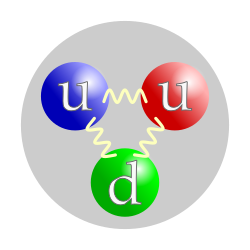The fundamental particles of matter
Elementary particles of matter[edit | edit source]
Since the beginning of human existence, various ideas about the composition of matter have arisen. Confirmation of the ancient theory of the atom as the basic component of matter was brought by research from the 19th century, when it was specified that the atom consists of elementary particles - a proton , a neutron and an electron . During the 20th century, a number of other particles and antiparticles (mirror particles that have the same mass but opposite electrical charge) were discovered . The discovered elementary particles can be divided into two main groups. They are leptons and hadrons.
Leptons[edit | edit source]
Leptons are the first group of elementary particles , which includes the electron and its related particles. We do not observe any internal structure in them up to current experimental possibilities, i.e. up to 10-18 m. All particles have spin 1/2, so they are so-called fermions (particles with half-numerical spin) interacting by weak interaction . Electrically charged particles (electrons) also interact electromagnetically and are able to interact with matter , unlike electrically negative particles ( neutrinos ), which only react very weakly with matter. Lepton interactions are governed by the law of conservation of lepton number L, which must match before and after the interaction. Today, 3 different lepton numbers are known, which are equal to +1 for electrons, muons , tauons and their neutrinos, and -1 for their antiparticles and antineutrinos . We know 12 types of leptons, 3 of which are charged (electron, muon, tauon), 3 neutrinos (electron, muon, tauon) and their 6 antiparticles .
Lepton generation
1st generation – electron and its neutrino
2nd generation – muon and its neutrino
3rd generation – tauon and its neutrino
We can artificially prepare these particles in accelerators. Antiparticles also belong to all generations.
Quarks[edit | edit source]
Quarks are the fundamental particles that make up hadrons . Individually occurring quarks have never been observed.
There are six types of hadron-forming quarks, distinguished by their "smells" ( up , down , strange , charm , bottom , top ).
Pairs of quarks, together with their antiquarks , are divided into three generations :
1st generation – u (up), d (down) quarks
2nd generation – s (strange), c (charm) quarks
3rd generation – quarks b (bottom), t (top).
Commonly found in nature are 1st generation quarks .
Clustered quarks form two types of hadrons – baryons and mesons . Baryons are formed by a triplet of quarks qqq , a proton by a triplet uud , and a neutron udd . Mesons always consist of one quark and one antiquark (qq̄) .
Quarks are colored charged particles. Each quark carries a color charge in one of three possible values - green , blue or red ( RGB ), each antiquark has one of three values of complementary charge. Quarks are never found alone, they are always combined in hadrons. The interaction energy between quarks in hadrons is greater the farther apart they are. It takes an infinite amount of energy to release a quark.
Strong interactions between quarks in hadrons are mediated by gluons - color-charged particles carrying the charge of color-anticolor pairs (eg red/anti-blue). A hadron as a whole must always be neutral in color , because that is the only way it can exist independently. Therefore, each quark in a baryon carries a different color.
The high-energy collision of hadrons can cause them to "melt" and create a so-called quark-gluon plasma . In it, quarks can move freely. This state of matter was supposed to be in the universe 20–30 microseconds after the Big Bang and can be created for an extremely short time in a particle accelerator.
Links[edit | edit source]
External Links[edit | edit source]
References[edit | edit source]
- RNDR. VÁVRA, PH.D., Václav. Základní stavební částice hmoty [online]. [cit. 2011-10-10]. <http://mineralogie.sci.muni.cz/kap_3_1_castice/kap_3_1_castice.htm>.
- ULMANN, Vojtěch. Jaderná a radiační fyzika [online]. [cit. 2008-4-5]. <http://astronuklfyzika.cz/JadRadFyzika5.htm>.
- – ROSINA, Jozef. Medicínská biofyzika. 1. edition. Grada, 2005. 524 pp. ISBN 80-247-1152-4.
- NEZNÁMÝ, Autor. aldebaran [online]. [cit. 2015-11-28]. <https://www.aldebaran.cz/astrofyzika/interakce/particles.html>.



